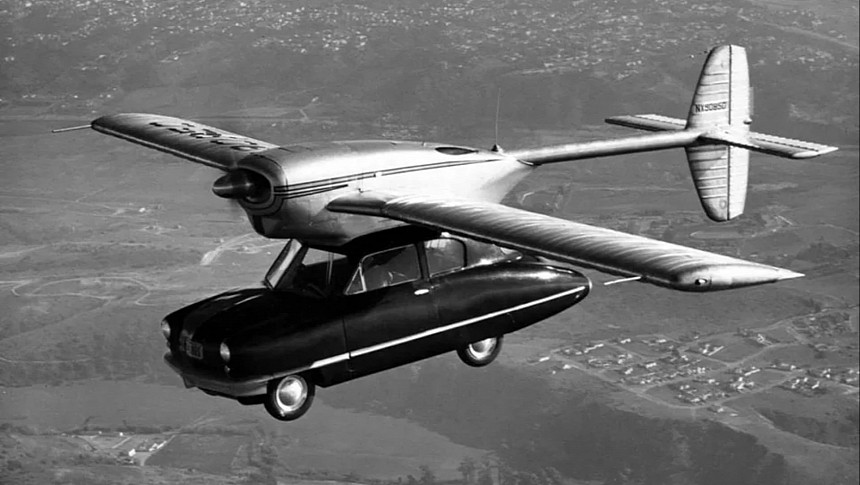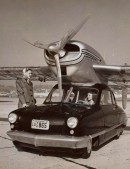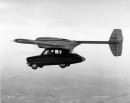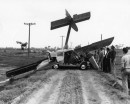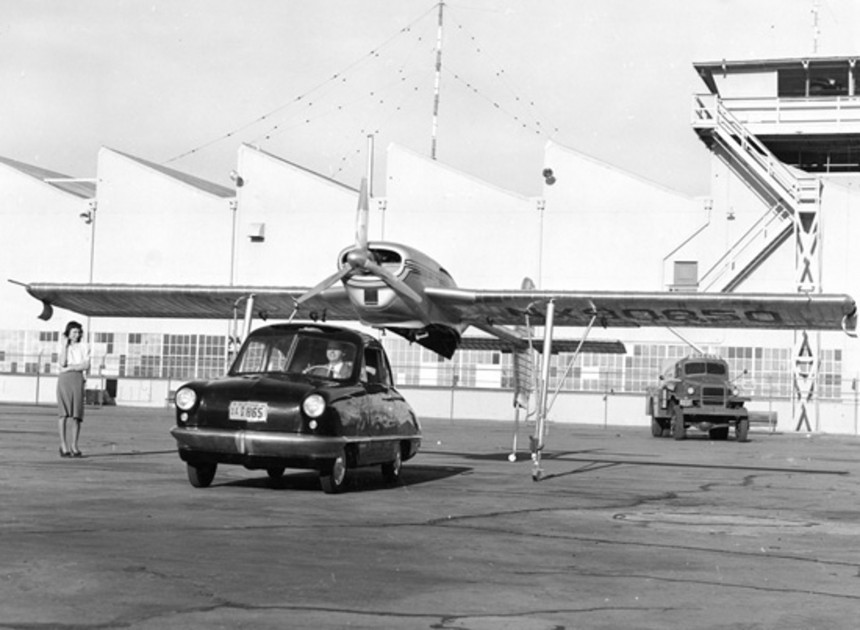Very rarely does a roadable aircraft, aka a flying car, ever make sense beyond the realm of an 11-year-old grade schooler's imagination. Only in the last decade has the idea become even remotely feasible. And even then, this only applies to the millionaires lucky enough to afford one. But that hasn't stopped dozens of engineers trying to bring a flying car to market over the years. Of all of these, perhaps the design with the most legs underneath it was built by a long-forgotten aerospace contractor that, many years ago, was one of the most ambitious manufacturers on U.S. domestic soil.
This is the story of the Convair Model 118, the flying car prototype that almost made sense in the late 1940s. Safe to say, every flying car built since shares at least a little bit of its DNA. Let's take a look at the details. Hardly anyone outside of dedicated enthusiast circles remembers Conviair in 2023. Having been absorbed into the General Dynamics corporation in the mid-1950s and most of its assets sold to Lockheed and McDonnell Douglas in the mid-1990s, Convair risks fading from living memory in the not-so-distant future.
As a result of the merger between the Buffalo, New York-based Consolidated Aircraft group with the Los Angeles-headquartered Vultee Aircraft, Convair merged into existence at the height of American involvement in World War II in 1943. Famous warbirds like the B-24 Liberator quad-engined bomber, the PBY Catalina seaplane, and the Vultee V-1 airliner were attributed to both sides of one of WWII's most important aerospace mergers. By the end of the war, the newly formed Convair was the fourth most valuable U.S. corporation by total contract value.
For some context, that's more valuable at the time than Boeing, Lockheed, or Douglas, a truly massive conglomerate by the day's standards. With the end of hostilities in World War II finally at hand by September 1945, the time had come for Convair to shift some of its focus away from wartime production and cater to markets outside of the military-industrial complex. At the same time that titans like the B-36 Peacemaker strategic bomber were under development at Convair's headquarters in San Diego, another, far quirkier project was underway at the very same facility.
At the helm of this bizarre flying car prototype was a man named Theodore P. "Ted" Hall. During the war, Hall envisioned using his blueprints for a flying car as a novel form of troop transport. It was a bit like a Jeep with wings, so to speak. But with the war now over, Hall's vision changed to that of a mass-market roadable aircraft that the masses could use to beat the traffic by renting them from local regional or international airports. At a time when the U.S. Federal Highway System had yet to be implemented, this was some fairly forward-thinking for the day. Together with the help of fellow engineer Tommy Thompson, the fruits of their labor resulted in the Convair Model 116.
The Model 116 was a peculiar vehicle in almost every respect. Almost resembling an egg with wings more than it did a roadable aircraft, the Model 116, or the ConvAirCar, as Convair designated it, used separate powertrains for road and air travel. An air-cooled Franklin 4A4 flat-four boxer engine jetting 90 horsepower took care of powering the craft in the air, paired to a two-bladed propeller in a tractor configuration. Meanwhile, a paltry 26 horsepower engine from Crosley, makers of the Hotshot sports car, took care of road-going operations.
The ConVairCar could cruise at roughly 112.5 mph (181.1 km/h, 97.8 kn), which was considerably faster than most production cars could manage on flat roads in the late 1940s. This strange chimera between aircraft and passenger cars made its first flight on July 12th, 1946, less than a year after the end of hostilities in World War II. The single prototype completed 66 test flights with pilot Russell Rogers behind the controls without a single major incident. But if there were any critique of the first ConVairCar, it was a constant and chronic lack of horsepower.
Simply modifying the existing airframe was one option. But Ted Hall wasn't satisfied with such a simple fix. He wanted to add a whole new layer of refinement to the mix with an entirely bespoke, brand-new roadable aircraft with the same DNA as the Model 116, just with a little bit more added capability. In November 1947, Hall and his design team at Convair got their wish in the form of the Model 118, the second ConVairCar. With a more powerful Lycoming O-435C flat-six making 190 hp, supplementing the same Crosley road engine as the Model 116, the Model 118 maxed out at 125 mph (201 kph, 109 kn) in the air while using a forward-facing propeller.
With a body much more in line with what typical American passenger cars looked like in the day, there was almost a sense it could've just as easily been built by GM, Ford, or Chrysler with its appearance. Seemingly high on his own supply, so to speak, Ted Hall envisioned a mass-production Model 118, which he could sell to the masses for a mere $1,500. Adjusted for inflation, this works out to roughly $20,500, give or take some change. Amazingly, Hall and his team anticipated consumer demand for as many as 160,000 units. Yeah, if that's not huffing some weapons-grade ambition, we don't know what is.
Dubious anticipations about the production scale aside, the Model 118 was quite possibly the most practical roadable aircraft ever built in the United States up to this point. But all this positive momentum was about to come to a grinding halt. During a test flight on November 18th, 1947, with pilot Reuben Snodgrass at the controls, the original Model 118 was forced to make a bingo fuel emergency landing just outside San Diego, which essentially totaled the airframe. In the following investigation, it was found that engineers accidentally mistook the aircraft's Crosley road engine fuel gauge for that of the Lycoming aviation engine.
The resulting mix-up sent the aircraft careening into the ground. It took two and a half months of extensive repairs, including an entirely new car body, to get the "plane" working again. The newly repaired flying car flew once again on January 29th, 1948, with pilot W.G. Griswold at the helm. But by this stage, Convair had already come to the sad conclusion that, at least by the technology standards of the day, a practical roadable aircraft was still a pie-in-the-sky fantasy. Even today, this is a sentiment that's still pervasive about flying cars. Before the 40s had concluded, Convair sold the rights to the ConVairCar to Ted Hall for him to make adjustments to himself.
Under the company name T.R Hall Engineering Corp, the man had every intention of fulfilling his ambitions of fielding Model 118s at every major airport in the nation. But of course, this never wound up happening, and Convair never again even attempted to design another roadable aircraft. With the War in Korea only a couple of years away by this stage, Convair was far too busy building B-36s and RIM-2 Terrier surface-to-air missile systems to bother with such flight-of-fancy pursuits. Whatever became of the remaining Model 118 isn't quite clear. However, it can be logically assumed that it was broken up for scrap soon after T.R. Hall Engineering Corp ceased work on the project.
Seventy-five years later, roadable aircraft have only very recently become technologically viable to the point where their full-scale operational deployment can even be brought into consideration. It was only in July 2023 that the FAA finally awarded flight certification to the first fully electric personal aircraft ostensibly considered by its makers, Alef Automotive, to be an EV flying car. Even so, the prototypes don't have any road wheels. It just goes to show flying cars are likely to be a red herring until someone can definitively prove to us they aren't anymore. Well, we're waiting.
As a result of the merger between the Buffalo, New York-based Consolidated Aircraft group with the Los Angeles-headquartered Vultee Aircraft, Convair merged into existence at the height of American involvement in World War II in 1943. Famous warbirds like the B-24 Liberator quad-engined bomber, the PBY Catalina seaplane, and the Vultee V-1 airliner were attributed to both sides of one of WWII's most important aerospace mergers. By the end of the war, the newly formed Convair was the fourth most valuable U.S. corporation by total contract value.
For some context, that's more valuable at the time than Boeing, Lockheed, or Douglas, a truly massive conglomerate by the day's standards. With the end of hostilities in World War II finally at hand by September 1945, the time had come for Convair to shift some of its focus away from wartime production and cater to markets outside of the military-industrial complex. At the same time that titans like the B-36 Peacemaker strategic bomber were under development at Convair's headquarters in San Diego, another, far quirkier project was underway at the very same facility.
At the helm of this bizarre flying car prototype was a man named Theodore P. "Ted" Hall. During the war, Hall envisioned using his blueprints for a flying car as a novel form of troop transport. It was a bit like a Jeep with wings, so to speak. But with the war now over, Hall's vision changed to that of a mass-market roadable aircraft that the masses could use to beat the traffic by renting them from local regional or international airports. At a time when the U.S. Federal Highway System had yet to be implemented, this was some fairly forward-thinking for the day. Together with the help of fellow engineer Tommy Thompson, the fruits of their labor resulted in the Convair Model 116.
The ConVairCar could cruise at roughly 112.5 mph (181.1 km/h, 97.8 kn), which was considerably faster than most production cars could manage on flat roads in the late 1940s. This strange chimera between aircraft and passenger cars made its first flight on July 12th, 1946, less than a year after the end of hostilities in World War II. The single prototype completed 66 test flights with pilot Russell Rogers behind the controls without a single major incident. But if there were any critique of the first ConVairCar, it was a constant and chronic lack of horsepower.
Simply modifying the existing airframe was one option. But Ted Hall wasn't satisfied with such a simple fix. He wanted to add a whole new layer of refinement to the mix with an entirely bespoke, brand-new roadable aircraft with the same DNA as the Model 116, just with a little bit more added capability. In November 1947, Hall and his design team at Convair got their wish in the form of the Model 118, the second ConVairCar. With a more powerful Lycoming O-435C flat-six making 190 hp, supplementing the same Crosley road engine as the Model 116, the Model 118 maxed out at 125 mph (201 kph, 109 kn) in the air while using a forward-facing propeller.
With a body much more in line with what typical American passenger cars looked like in the day, there was almost a sense it could've just as easily been built by GM, Ford, or Chrysler with its appearance. Seemingly high on his own supply, so to speak, Ted Hall envisioned a mass-production Model 118, which he could sell to the masses for a mere $1,500. Adjusted for inflation, this works out to roughly $20,500, give or take some change. Amazingly, Hall and his team anticipated consumer demand for as many as 160,000 units. Yeah, if that's not huffing some weapons-grade ambition, we don't know what is.
The resulting mix-up sent the aircraft careening into the ground. It took two and a half months of extensive repairs, including an entirely new car body, to get the "plane" working again. The newly repaired flying car flew once again on January 29th, 1948, with pilot W.G. Griswold at the helm. But by this stage, Convair had already come to the sad conclusion that, at least by the technology standards of the day, a practical roadable aircraft was still a pie-in-the-sky fantasy. Even today, this is a sentiment that's still pervasive about flying cars. Before the 40s had concluded, Convair sold the rights to the ConVairCar to Ted Hall for him to make adjustments to himself.
Under the company name T.R Hall Engineering Corp, the man had every intention of fulfilling his ambitions of fielding Model 118s at every major airport in the nation. But of course, this never wound up happening, and Convair never again even attempted to design another roadable aircraft. With the War in Korea only a couple of years away by this stage, Convair was far too busy building B-36s and RIM-2 Terrier surface-to-air missile systems to bother with such flight-of-fancy pursuits. Whatever became of the remaining Model 118 isn't quite clear. However, it can be logically assumed that it was broken up for scrap soon after T.R. Hall Engineering Corp ceased work on the project.
Seventy-five years later, roadable aircraft have only very recently become technologically viable to the point where their full-scale operational deployment can even be brought into consideration. It was only in July 2023 that the FAA finally awarded flight certification to the first fully electric personal aircraft ostensibly considered by its makers, Alef Automotive, to be an EV flying car. Even so, the prototypes don't have any road wheels. It just goes to show flying cars are likely to be a red herring until someone can definitively prove to us they aren't anymore. Well, we're waiting.
